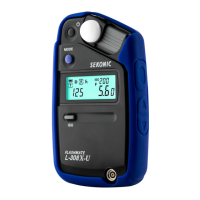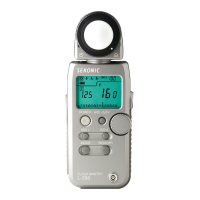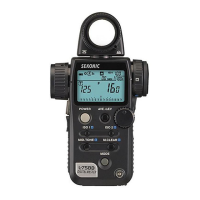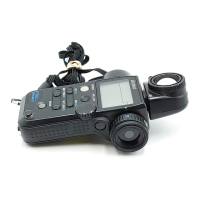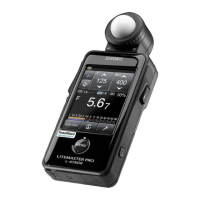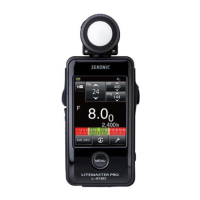As the Studio
Deluxe is
a
high
precision
measuring
instrument,
by
f
ully utilizing
its
capabilities,
its
special
f unctions
can be
displayed
covering an additionally
wide range
of applications.
Incident light
measurement
is
an extremely
practical
method in
actual
photo-
graphic
situations and
is often employed
by
professional photogra-
phers
and cinematographers. Since
proper
exposure
can be
determined
even in
cases where
errors
are
easily incurred
with
reflected
light measurement, it is extremely convenient for
both
color and
monochrome.
The
Lumisphere
displays
its
optimum value when
used for incldent
light measurement
during color or
monochrome
photography
of
f leshtones
(portrait
photography
in
which
f leshtones
are considered
as the main
picture
element for
determining
exposure) . Since
good
or bad
quality portrayals
can be discerned even by amateurs,
fleshtones
become the only true standard
in
color
photography.
(They
can
also
be
given
a wider
range
of artistic
expression than
visible
to
the
naked
eve.)
Well
known
basic
princi ples
form
the
foundation
of the Studio
Deluxe,
however,
plenty
of
latitude is
provided
for
obtaining special
effects.
By allowing
variations
in exposure
to be
performed,
exactiy
the
same
reproductions
become
possible
as those
learned
only
f
rom
experience. Utilizing the selection of accessories also
opens the way
to
the multitude of
applications
described
in
the
preceding pages.
Light
balance measurements are the most
important
application of
the Lumidisc. This
consists of measuring the
ratio
of main
light
and
f
ill in light in order
to
perform
vital
adjustments when
photograph-
ing
an
illuminated
subject. The
photographer
is
advised
to record
the data obtained
for
his
particular
equipment. This will
provide
ready reference
in the
f
uture
and allow the same
lighting
conditions
to be
reproduced.
When
shooting in a studio or similar
situation where artificial
lighting
equipment is used, more
attractive
results
can be
produced
by making the main and fill in light ratio 4
:1
-
2:1. Alsowhen
using ref lectors either indoors
or outdoors, determine the exposure
after measuring the
illumination ratio.
Normal
sunlight becomes the main
light
source outdoors,
while
white or silver ref
lectors
are
used
to brighten shadow
portions
of the
subject.
In this
situation,
install
the Lumidisc,
point
it
toward the
sun and
read
the
indicated
value. Next,
point
the Lumidisc toward
the
reflector
(shield
with hand to
avoid sunlight) and again
read
the
indicated value. To obtain maximum
color
effect,
this
fill in light
source should be
112
-
114 of the main
lignt.
An
additional theatrical
effect
can be
produced
with monochrome
by
using
a higher illumination
ratio. lt is
suggested,
for example,
to
use
a
ratio
between
fill
in light
and
sunlight of 1116 or
lower.
lf
the meter
needle
deflects beyond
scale, use the
H
slide and
as
described
earlier,
multiply the
indicated value
by 32. Then calculate
main and
fill
in
lighting
(see
section
on
*Contrast
measurement).
After completing
light
balance adjustment, replace Lumisphere and
measure exposure
by
normal
method. At
this
time, hold the
Lumisphere
close to the subject to
fully
detect
sunlight
and
fill in
light.

